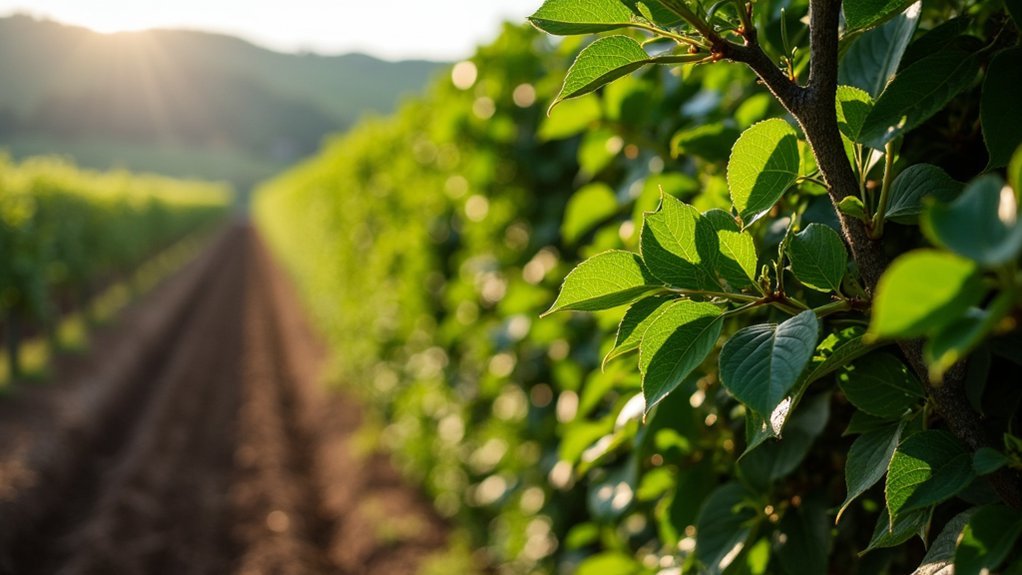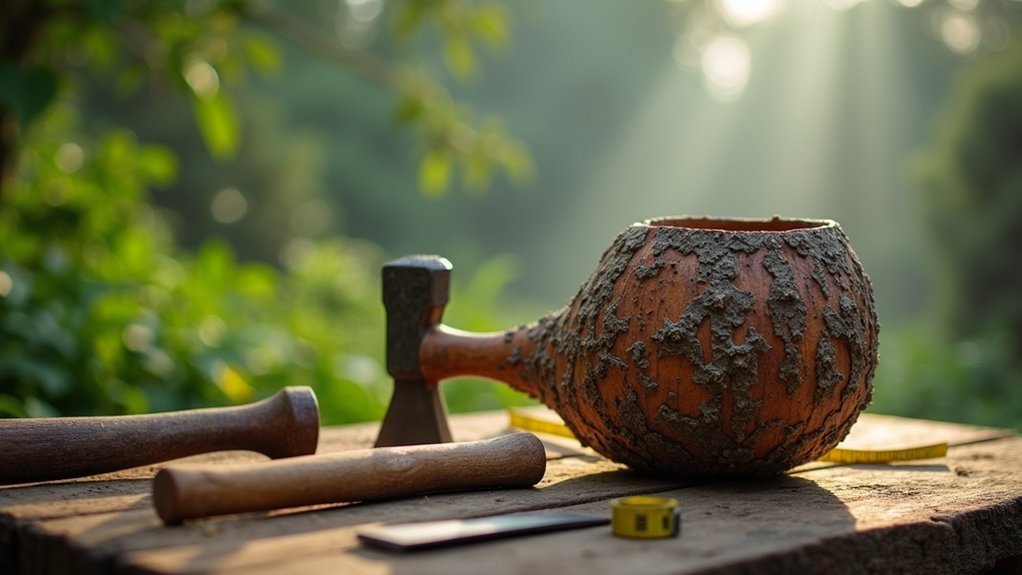Mastering the Midland Bullock hedge technique connects you to centuries of agricultural heritage while providing practical benefits. You’ll create livestock-proof barriers that double as wildlife habitats supporting nearly 1,000 plant species. This traditional method originated in Leicestershire and Northamptonshire between 1750-1850 specifically for containing heavy bullocks. With proper tools and staking techniques, you’ll transform ordinary hedgerows into rural artistry that enhances your landscape. The rich history and ecological advantages await your discovery.
7 Second-Level Headings for “Why Master the Midland Bullock Hedge Technique?”

Why should anyone invest time in learning this specialized hedgelaying method? The Midland Bullock technique offers compelling benefits beyond mere boundary creation. These benefits range from practical agricultural applications to cultural preservation.
The Midland Bullock technique transforms ordinary hedgerows into rural artistry while solving practical agricultural challenges.
Robust Livestock Containment
Your farm’s hedges need to withstand the pressure of heavy livestock, particularly in traditional beef-rearing regions.
The Midland Bullock technique creates exceptionally sturdy barriers with its distinctive pattern of pleachers and stakes.
Cultural Heritage Preservation
By mastering this regional method, you’re keeping alive skills that shaped the English countryside for centuries.
Community Connection
Learning this technique typically involves joining others who share your interest, creating valuable networks within rural communities while reviving traditional agricultural practices.
The Historical Origins of Midland Bullock Hedging
You’ll find the Midland Bullock hedge technique emerged directly from the practical needs of beef farmers in Leicestershire and Northamptonshire during the agricultural revolution of the 1750s-1850s.
This distinctive style was specifically crafted to contain hefty bullocks, with its 45° angled pleachers creating a stronger barrier than other regional variations.
The technique’s development mirrors the evolution of cattle farming practices across the Midlands, where local hedgelayers refined their craft to match the specific challenges of their agricultural landscape.
Cattle-Proof Heritage
While many hedging techniques have evolved across Britain, the Midland Bullock hedge stands apart with its distinctive agricultural legacy. You’ll find this method deeply rooted in the beef-rearing traditions of Leicestershire and Northamptonshire, where farmers needed reliable barriers to contain their powerful livestock.
| Feature | Purpose |
|---|---|
| 1-meter height | Ideal containment of bullocks |
| Angled pleachers | Enhanced structural strength |
| Strategic stake spacing | Superior support system |
| Dense weaving pattern | Prevents livestock breakthrough |
| Low maintenance design | Sustainable longevity |
The Midland hedge technique emerged as a practical solution to a specific agricultural challenge. When you implement this method, you’re not just creating a boundary—you’re preserving a piece of rural heritage that balanced farming necessities with ecological benefits, supporting biodiversity while effectively managing livestock movement across the landscape.
Regional Evolution Patterns
As agricultural demands evolved across central England during the 18th century, the Midland Bullock hedge technique emerged as a specialized response to local farming challenges.
When you examine the regional variations, you’ll notice how the Midland style adapted to specific livestock management needs in counties like Leicestershire and Northamptonshire.
During the hedge planting boom of 1750-1850, when pleachers are laid in the distinctive Midland pattern, they create barriers specifically designed to contain heavy bullocks.
This technique’s evolution wasn’t uniform—the Staffordshire variant demonstrates how local materials and farming practices influenced regional adaptations.
You’re looking at a living agricultural technology that evolved precisely where beef production demanded sturdier containment solutions.
At approximately one meter high, these hedges represent centuries of practical agricultural knowledge refined through regional experimentation.
Essential Tools and Materials for Authentic Bullock Style Hedging

You’ll need a specialized double-edged billhook to effectively cut and thin pleachers when creating an authentic Midland Bullock hedge.
Select sturdy stakes about 4cm in diameter, setting them 50cm deep to provide the structural foundation that supports your laid stems.
For proper binding, source hazel rods approximately 3m long and 25mm thick, or consider alternatives like sweet chestnut, elm, or willow if hazel isn’t available.
Traditional Billhooks Matter
When crafting a genuine Midland Bullock hedge, the traditional billhook remains an irreplaceable companion to any serious hedgelayer.
These essential tools feature double-edged blades specifically designed for precise thinning and trimming of pleachers, ensuring your hedge is laid with maximum effectiveness.
You’ll appreciate that authentic billhooks are solid-forged from a single piece of steel, providing the durability needed to tackle tough hedging materials.
This strength becomes vital when you’re working with 4cm diameter stakes and flexible hazel bindings that form the structural framework of your hedge.
Mastering these traditional tools isn’t just about preserving heritage techniques—it directly impacts both the aesthetic appeal and ecological benefits of your finished hedge.
Your investment in quality billhooks will pay dividends in the precision and longevity of every Bullock style hedge you create.
Hazel Binding Techniques
Three critical elements define successful hazel binding in authentic Bullock hedging: material selection, preparation, and application technique.
You’ll want to select hazel rods approximately 3 meters long with a diameter of about 25mm – these dimensions provide the perfect balance of flexibility and strength needed for secure binding.
When preparing your materials, choose fresh hazel that bends easily without snapping. This traditional material isn’t just aesthetically pleasing; it’s also environmentally sustainable when locally sourced.
For proper application, weave the tops of pleachers between stakes while binding. This creates the robust structure necessary for containing livestock while promoting hedge health.
Your binding technique will largely determine how well your hedge performs its dual role as a living barrier and ecological asset in the landscape.
Stake Selection Guidelines
Moving from binding to the framework that holds it all together, proper stake selection forms the backbone of every successful Bullock hedge.
You’ll want stakes approximately 4cm in diameter and 50cm deep for ideal stability. Traditional hedges make the most impact when you use authentic materials like hazel, which offers both durability and flexibility for proper shaping.
Space your stakes evenly at 50cm intervals to maintain structural integrity while allowing sufficient growth.
Always prioritize untreated wood to prevent harmful chemicals from leaching into your soil and damaging both the hedge and surrounding ecosystem.
Consider locally available wood species traditionally used in your region, ensuring your stake selection remains both authentic and sustainable.
This thoughtful approach preserves historical techniques while creating a hedge that will thrive for generations.
Step-by-Step Guide to Cutting and Preparing Pleachers

The foundation of a successful Midland Bullock hedge lies in properly cut and prepared pleachers.
Begin your hedge-laying process by clearing dead wood and irregular growth to create a clean workspace. When cutting pleachers, position your cuts 3-10cm above ground level, selecting young, healthy stems that will regenerate vigorously.
Don’t be too quick to discard spare pleachers; keep them until you’re certain they’re unnecessary for maintaining hedge density.
Trim excess brush from the nearside to facilitate the weaving process later on.
For binding your laid pleachers, select hazel, sweet chestnut, or elm rods approximately 3m long and 25mm in diameter.
These binders will secure your pleachers in position, creating the distinctive woven pattern characteristic of the Midland Bullock technique.
Mastering the Staking and Weaving Techniques
Proper staking forms the backbone of your Midland Bullock hedge, providing essential support for the pleachers you’ve carefully prepared. Select stakes approximately 4cm in diameter and sink them 50cm into the ground to guarantee they’ll withstand pressure from the laid pleachers and environmental forces.
When weaving, you’ll need to intertwine the brushy tops of your pleachers between these stakes with deliberate care. This vital step creates the dense, cohesive barrier that makes the Midland Bullock technique so effective.
After your pleachers are properly laid and woven, trim the stake tops to create a clean, uniform appearance.
Remember that successful staking depends on proper spacing and depth. Your finished hedge should display a harmonious balance between the structural support of the stakes and the natural flow of the woven pleachers.
Regional Variations and Special Considerations

While the Midland Bullock technique follows core principles, regional adaptations have emerged across different counties to address local conditions and livestock needs.
When working in Northamptonshire, you’ll notice hedges are often built higher and denser than in neighboring areas, specifically designed to keep larger beef cattle contained.
In Leicestershire, the spacing between stakes might be reduced to 40cm in areas with particularly determined livestock. Understanding the whys and wherefores of these subtle variations will markedly improve your hedging results.
Consider soil composition too—clay-heavy regions require different pleaching angles than sandy soils.
Weather patterns also influence technique; windier areas benefit from additional brush on the weather-facing side.
Remember that these regional adaptations aren’t merely traditional preferences but practical solutions developed through centuries of agricultural experience.
Ecological Benefits of Traditional Hedge Laying
Beyond its practical agricultural applications, Midland Bullock hedge laying delivers remarkable ecological advantages that extend far beyond the boundaries of your farm.
When you implement this traditional hedge laying technique, you’re creating dense wildlife habitats that support nearly 1,000 plant species and countless animals, from birds to invertebrates.
You’ll notice improved soil health as your hedges prevent erosion and runoff during heavy rains. They’ll also serve as crucial wildlife corridors, connecting fragmented habitats and supporting genetic diversity within local species populations.
Perhaps most importantly in today’s changing climate, your hedges actively sequester carbon in the soil, contributing to climate change mitigation.
Frequently Asked Questions
What Are the Benefits of Hedgelaying?
Hedgelaying benefits you by enhancing biodiversity, creating livestock barriers, preventing soil erosion, improving landscape aesthetics, and preserving rural heritage. You’ll maintain habitats for wildlife while connecting with traditional agricultural practices.
Why Are Hedges Important?
Hedges are important because they’ll protect your land, boost biodiversity, prevent soil erosion, add beauty to landscapes, and create beneficial microclimates. You’re preserving habitats for countless species when you maintain hedges.
What Is the History of Hedge Laying?
Hedge laying’s history stretches back to Roman times. You’ll find it flourished during 1750-1850 when farmers planted 2,000 miles annually. It’s evolved into regional styles like Midland Bullock, reflecting local agricultural needs and practices.
What Is the South of England Style of Hedge Laying?
You’ll recognize the South of England style by its 45-degree pleachers and closely spaced stakes (50-60cm apart). It creates a tidy, 1-1.2m tall stock-proof barrier with minimal brush, often using hazel for binding.
In Summary
You’ll find mastering the Midland Bullock hedge technique is truly worth your effort. It’s not just about preserving a traditional craft—you’re creating living boundaries that enhance biodiversity, provide wildlife habitats, and strengthen the countryside’s character. As you develop your skills, you’ll connect with generations of rural craftspeople while creating robust, beautiful hedgerows that will stand for decades to come.





Leave a Reply